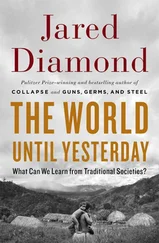Jared Diamond - The rise and fall of the third chimpanzee
Здесь есть возможность читать онлайн «Jared Diamond - The rise and fall of the third chimpanzee» весь текст электронной книги совершенно бесплатно (целиком полную версию без сокращений). В некоторых случаях можно слушать аудио, скачать через торрент в формате fb2 и присутствует краткое содержание. Год выпуска: 1991, ISBN: 1991, Издательство: RADIUS, Жанр: Биология, на английском языке. Описание произведения, (предисловие) а так же отзывы посетителей доступны на портале библиотеки ЛибКат.
- Название:The rise and fall of the third chimpanzee
- Автор:
- Издательство:RADIUS
- Жанр:
- Год:1991
- ISBN:0-09-174268-4
- Рейтинг книги:4 / 5. Голосов: 1
-
Избранное:Добавить в избранное
- Отзывы:
-
Ваша оценка:
- 80
- 1
- 2
- 3
- 4
- 5
The rise and fall of the third chimpanzee: краткое содержание, описание и аннотация
Предлагаем к чтению аннотацию, описание, краткое содержание или предисловие (зависит от того, что написал сам автор книги «The rise and fall of the third chimpanzee»). Если вы не нашли необходимую информацию о книге — напишите в комментариях, мы постараемся отыскать её.
The rise and fall of the third chimpanzee — читать онлайн бесплатно полную книгу (весь текст) целиком
Ниже представлен текст книги, разбитый по страницам. Система сохранения места последней прочитанной страницы, позволяет с удобством читать онлайн бесплатно книгу «The rise and fall of the third chimpanzee», без необходимости каждый раз заново искать на чём Вы остановились. Поставьте закладку, и сможете в любой момент перейти на страницу, на которой закончили чтение.
Интервал:
Закладка:
For example, in New Guinea until recently, each tribe maintained a shifting pattern of warfare and alliance with each of its neighbours. A person might enter the next valley on a friendly visit (never quite without danger) or on a war raid, but the chances of being able to traverse a sequence of several valleys in friendship were negligible. The powerful rules about treatment of one's fellow 'us' did not apply to 'them', those dimly understood, neighbouring enemies. As I walked between New Guinea valleys, people who themselves practised cannibalism and were only a decade out of the Stone Age routinely warned me about the unspeakably primitive, vile, and cannibalistic habits of the people whom I would encounter in the next valley. Even Al Capone's gangs in twentieth-century Chicago made a policy of hiring out-of-town killers, so that the assassin could feel that he was killing one of'them' rather than of 'us'.
The writings of classical Greece reveal an extension of this tribal territorialism. The known world was larger and more diverse, but 'us' Greeks were still distinguished from 'them' barbarians. Our word 'barbarian' is derived from the Greek barbaroi, which simply means non-Greek foreigners. Egyptians and Persians, whose level of civilisation was like that of the Greeks, were nevertheless barbaroi. The ideal of conduct was not to treat all men equally, but instead to reward one's friends and to punish one's enemies. When the Athenian author Xenophon wanted to express the highest praise for his admired leader Cyrus, Xenophon related how Cyrus always repaid his friends' good turns more generously, and how Cyrus retaliated on his enemies' misdeeds more severely (for example, by gouging.out their eyes or cutting off their hands).
Humans, like the Mungi and Scratching Rock hyena clans, practised a dual standard of behaviour, with strong inhibitions about killing one of us', but a green light to kill 'them' when it was safe to do so. Genocide was acceptable under this dichotomy, whether one considers the dichotomy as an inherited animal instinct or as a uniquely human ethical code. We all still acquire in childhood our own arbitrary dichotomous criteria for respecting or scorning other humans. I recall a scene at Goroka airport in the New Guinea highlands, when my Tudawhe field assistants were standing awkwardly in torn shirts and bare feet, and an unshaven, unwashed white man with a strong Australian accent and hat crumpled over his eyes approached. Even before he had begun to sneer at the Tudawhes as 'black burns, they won't be fit to run this country for a century', I had begun to think to myself, 'Dumb Aussie redneck, why doesn't he go home to his goddamn sheep dip. There it was, a blueprint for genocide: I scorning the Australian, and he scorning the Tudawhes, based on collective characteristics taken in at a glance. With time, this ancient dichotomizing has become increasingly unacceptable as a basis for an ethical code. Instead, there has been some tendency towards paying at least lip-service to a universal code—that is, one stipulating similar rules for treating different peoples. Genocide conflicts directly with a universal code.
Despite this ethical conflict, numerous modern perpetrators of genocide have managed to take unabashed pride in their accomplishments. When Argentina's General Julio Argentine Roca opened the pampas for white settlement by ruthlessly exterminating the Araucanian Indians, a delighted and grateful Argentinian nation elected him president in 1880. How do today's practitioners of genocide wriggle out of the conflict between their actions and a universal code of ethics? They resort to one of three types of rationalizations, all of which are variations on a simple psychological theme, 'Blame the victim!
Firstly, most believers in a universal code still consider self-defence justified. This is a usefully elastic rationalization, because 'they' can invariably be provoked into some behaviour adequate to justify self-defence. For instance, the Tasmanians delivered an excuse to genocidal white colonists by killing an estimated total of 183 colonists over thirty-four years, while being provoked by a far greater number of mutilations, kidnappings, [apes, and murders. Even Hitler claimed self-defence in starting the Second World War, and he went to the trouble of faking a Polish attack on a German border post.
Possessing the 'right' religion or race or political belief, or claiming to represent progress or a higher level of civilization, is a second traditional justification for inflicting anything, including genocide, on those possessing the wrong principle. When I was a student in Munich in 1962, unrepentant Nazis still explained to me matter-of-factly that the Germans had had to invade Russia, because the Russian people had adopted Communism. My fifteen field assistants in New Guinea's Fakfak Mountains all looked pretty similar to me, but eventually they began explaining to me which of them were Moslems and which were Christians, and why the former (or the latter) were irredeemably lower humans. There is an almost universal hierarchy of scorn, according to which literate peoples with advanced metallurgy (for instance, white colonialists in Africa) look down on herders (such as Tutsi, Hottentots), who look down on farmers (such as Hutu), who look down on nomads or hunter-gatherers (such as Pygmies, Bushmen).
Finally, our ethical codes regard animals and humans differently. Hence modern perpetrators of genocide routinely compare their victims to animals in order to justify the killings. Nazis considered Jews to be subhuman lice; the French settlers of Algeria referred to local Moslems as ratons (rats); 'civilized' Paraguayans described the Ache hunter-gatherers as rabid rats; Boers called Africans bobbejaan (baboons); and educated northern Nigerians viewed Ibos as subhuman vermin. The English language is rich in animal names used as pejoratives: you pig (ape, bitch, cur, dog, ox, rat, swine).
All three types of ethical rationalizations were employed by Australian colonists to justify exterminating Tasmanians. However, my fellow Americans and I can obtain a better insight into the rationalization process by focusing on the case that we have been trained from childhood to rationalize: our not-quite-complete extermination of American Indians. A set of attitudes that we absorb goes roughly as follows.
To begin with, we do not discuss the Indian tragedy much—not nearly as much as the genocide of the Second World War in Europe, for instance. Our great national tragedy is instead viewed as the Civil War. Insofar as we stop to think about white versus Indian conflict, we consider it as belonging to the distant past, and we describe it in military language, such as the Pequod War,
Great Swamp Fight, Battle of Wounded Knee, Conquest of the West, and so on. Indians, in our view, were warlike and violent even towards other Indian tribes, masters of ambush and treachery. They were famous for their barbarity, notably for the distinctively Indian practices of torturing captives and scalping enemies. They were few in number and lived as nomadic hunters, especially bison hunters. The Indian population of the US as of 1492 is traditionally estimated at one million. This figure is so trivial, compared to the present US population of 250 million, that the inevitability of whites occupying this virtually empty continent becomes immediately apparent. Many Indians died from smallpox and other diseases. The aforementioned attitudes guided the Indian policy of the most admired US presidents and leaders from George Washington onwards (see quotations at the end of this chapter).
These rationalizations rest on a transformation of historical facts. Military language implies declared warfare waged by adult male combatants. Actually, common white tactics were sneak attacks (often by civilians) on villages or encampments to kill Indians of any age and either sex. Within the first century of white settlement, governments were paying scalp bounties to semi-professional killers of Indians. Contemporary European societies were at least as warlike and violent as Indian societies, when one considers the European frequency of rebellions, class wars, drunken violence, legalized violence against criminals, and total war including destruction of food and property. Torture was exquisitely refined in Europe: think of drawing and quartering, burning at the stake, and the rack. While the pre-contact Indian population of North America is the subject of widely varying opinions, plausible recent estimates are about eighteen million, a population not reached by white settlers of the US till around 1840. Although some Indians in the US were semi-nomadic hunters without agriculture, most were settled farmers living in villages. Disease may well have been the biggest killer of Indians, but some of the epidemics were intentionally transmitted by whites, and the epidemics still left plenty of Indians to kill by more direct means. It was only in 1916 that the last 'wild' Indian in the US (the Yahi Indian known as Ishi) died, and frank and unapologetic memoirs by the white killers of his tribe were still being published as recently as 1923.
Читать дальшеИнтервал:
Закладка:
Похожие книги на «The rise and fall of the third chimpanzee»
Представляем Вашему вниманию похожие книги на «The rise and fall of the third chimpanzee» списком для выбора. Мы отобрали схожую по названию и смыслу литературу в надежде предоставить читателям больше вариантов отыскать новые, интересные, ещё непрочитанные произведения.
Обсуждение, отзывы о книге «The rise and fall of the third chimpanzee» и просто собственные мнения читателей. Оставьте ваши комментарии, напишите, что Вы думаете о произведении, его смысле или главных героях. Укажите что конкретно понравилось, а что нет, и почему Вы так считаете.












